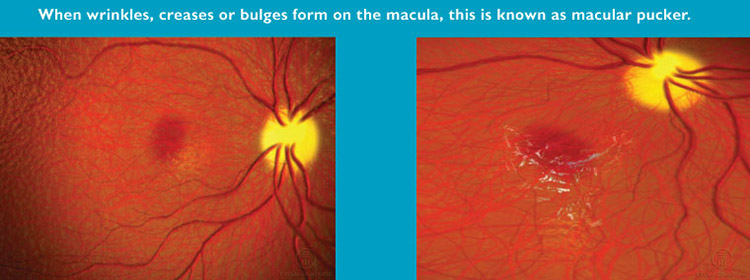Macular pucker is a kind of scar tissue that has formed over the eye’s macula. This condition is also referred to as epiretinal membrane, premacular fibrosis and retina wrinkle, among other names. Learn about the symptoms, causes and treatment for macular pucker below.
What Is Macular Pucker?
If the eye was likened to a camera, the very front of the eye consists of a lens that helps brings images into focus at the back of the eye. This light-sensitive area at the back of the eye is known as the retina. Special nerve cells are grouped at the center of the retina, an area called the macula. The nerve cells of the macula are where images are brought into focus, helping you achieve the sharp, straight-ahead vision required for tasks such as reading, driving and seeing fine detail.
Normally, the macula is flush against the back part of the eye, or retina. It must lie flat in order to function properly. In some cases, however, cells grow over this area of the eye, creating an extra layer of tissue. This tissue pulls on the macula, resulting in what is known as a macular pucker. A macular pucker may not lead to any noticeable changes in vision, or it may lead to significant distortions in eyesight.
What Causes Macular Pucker?
Macular pucker occurs due to age or injury-related changes on the surface of the retina. The gel-like substance called vitreous is responsible for helping the eye maintain its round shape. This substance fills about 80 percent of the eye.
In normal aging, the vitreous gradually shrinks away from the surface of the retina, a process referred to as vitreous detachment. For most people, this results in only minor effects, such as floaters in the field of vision. In others, once the vitreous pulls away, microscopic damage occurs on the retinal surface. As a result, the retina “heals” itself by forming scar tissue. The scar tissue causes wrinkling on the retina, and the macula can no longer lie flat against the back part of the eye.
Macular pucker may also be the result of an eye injury or medical condition such as diabetes.
What Are the Symptoms of Macular Pucker?
Symptoms of macular pucker vary widely, ranging from no changes in vision to severe changes. Cases of severe vision loss are less common.
If you have a macular pucker, you might notice visual changes such as blurry, distorted or wavy vision. You may also have trouble seeing fine detail and reading fine print. Some people also have a blind spot, or gray area, at the center of the visual field.
How Is Macular Pucker Treated?
The course of action for a macular pucker depends on a thorough examination of your eyes and a review of your medical history. Mild symptoms of macular pucker may not require any treatment aside from more frequent eye exams. Your doctor may also suggest a change in the prescription for your eyeglasses or contact lens.
Severe macular pucker symptoms may require vitrectomy surgery. The goal of vitrectomy surgery is to remove the retinal scar tissue so that the macula can lie flat in its proper position at the back of the eye. Successful surgery may result in gradual improvements in vision.
If you have experienced any recent changes in your vision, contact your Kansas City ophthalmologist right away for an appointment. Having a screening at our eye care clinic is the best way to determine if you are suffering from macular pucker or another related condition.
*Note: image courtesy of Rand Eye Institute
Posted November 8, 2017 by Silverstein Eye Centers